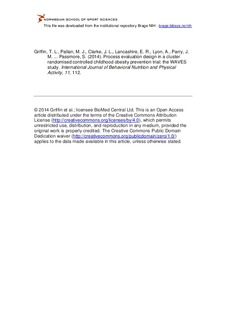| dc.contributor.author | Griffin, Tania L. | |
| dc.contributor.author | Pallan, Miranda J. | |
| dc.contributor.author | Calrke, Joanne L. | |
| dc.contributor.author | Lancashire, Emma R. | |
| dc.contributor.author | Lyon, Anna | |
| dc.contributor.author | Parry, Jane M. | |
| dc.contributor.author | Adab, Peymane | |
| dc.contributor.author | Barrett, Tim | |
| dc.contributor.author | Cheng, Kar Keung | |
| dc.contributor.author | Daley, Amanda | |
| dc.contributor.author | Deeks, Jon | |
| dc.contributor.author | Duda, Joan L. | |
| dc.contributor.author | Frew, Emma | |
| dc.contributor.author | Gill, Paramijt | |
| dc.contributor.author | Hemming, Karla | |
| dc.contributor.author | Ekelund, Ulf | |
| dc.contributor.author | Cade, Janet | |
| dc.contributor.author | Bhopal, Raj | |
| dc.contributor.author | McGee, Eleanor | |
| dc.contributor.author | Passmore, Sandra | |
| dc.date.accessioned | 2015-06-01T12:09:43Z | |
| dc.date.available | 2015-06-01T12:09:43Z | |
| dc.date.issued | 2014-09-10 | |
| dc.identifier.citation | International Journal of Behavioral Nutrition and Physical Activity. 2014, 11, 112 | nb_NO |
| dc.identifier.uri | http://hdl.handle.net/11250/284353 | |
| dc.description | © 2014 Griffin et al.; licensee BioMed Central Ltd. | nb_NO |
| dc.description.abstract | The implementation of a complex intervention is heavily influenced by individual context. Variation in implementation and tailoring of the intervention to the particular context will occur, even in a trial setting. It is recognised that in trials, evaluating the process of implementation of a complex intervention is important, yet process evaluation methods are rarely reported. The WAVES study is a cluster randomised controlled trial to evaluate the effectiveness of an obesity prevention intervention programme targeting children aged 6¿7 years, delivered by teachers in primary schools across the West Midlands, UK. The intervention promoted activities encouraging physical activity and healthy eating. This paper presents the methods used to assess implementation of the intervention.
Methods: Previous literature was used to identify the dimensions of intervention process and implementation to be assessed, including adherence, exposure, quality of delivery, participant responsiveness, context, and programme differentiation.
Results: Multiple methods and tools were developed to capture information on all these dimensions. These included observations, logbooks, qualitative evaluation, questionnaires and research team reflection.
Discussion: Data collection posed several challenges, predominantly when relying on teachers to complete paperwork, which they saw as burdensome on top of their teaching responsibilities. However, the use of multiple methods helped to ensure data on each dimension, where possible, was collected using more than one method. This also allowed for triangulation of the findings when several data sources on any one dimension were available.
Conclusions: We have reported a comprehensive approach to the assessment of the implementation and processes of a complex childhood obesity prevention intervention within a cluster randomised controlled trial. These approaches can be transferred and adapted for use in other complex intervention trials. | nb_NO |
| dc.language.iso | eng | nb_NO |
| dc.publisher | BioMed Central | nb_NO |
| dc.subject | cluster randomised controlled trial | nb_NO |
| dc.subject | intervention | nb_NO |
| dc.subject | childhood obesity prevention | nb_NO |
| dc.subject | process evaluation | nb_NO |
| dc.subject | implementation fidelity | nb_NO |
| dc.title | Process evaluation design in a cluster randomised controlled childhood obesity prevention trial: the WAVES study | nb_NO |
| dc.type | Journal article | nb_NO |
| dc.type | Peer reviewed | nb_NO |
| dc.subject.nsi | VDP::Social science: 200::Social science in sports: 330 | nb_NO |
| dc.subject.nsi | VDP::Medical disciplines: 700::Sports medicine: 850 | nb_NO |
| dc.source.journal | International Journal of Behavioral Nutrition and Physical Activity | nb_NO |
| dc.description.localcode | Seksjon for idretssmedisinske fag / Department of Sports Medicine | nb_NO |
